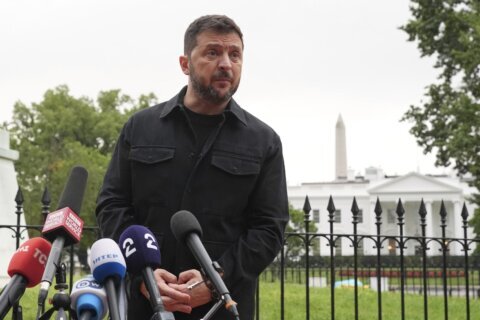WASHINGTON — After almost a year of silence, on Aug. 22, ISIS leader Abu Bakr al-Baghdadi released a 55-minute-long audio message admitting the group had been conquered, but telling his followers to keep fighting.
U.S. military officials are confident — but not certain — that the voice on the message is that of Baghdadi.
“We do believe that could possibly be him, although we have not got a confirmation on that,” Army Colonel Sean Ryan, spokesman for Operation Inherent Resolve, told WTOP from Baghdad. “But we’ve always said from the get go that we still believe that he is alive somewhere.”
But Ryan noted there was something different about this message.
“The message he put out is not typical of what he normally puts out,” Ryan said. “He did mention that they have been defeated, and I think he is just trying to rally up the very hardened ideologists to stick around claiming there’s gonna be better things.”
But Baghdadi, Ryan believes, has been weakened and discredited by his absence.
“He hasn’t been heard from in the last 11 months and hasn’t been seen for around three years, so that’s not the sign of a strong leader,” Ryan said. He said Baghdadi’s appearance now is “one last ditch attempt” to stop the organization from completely imploding.
“There’s a lot of infighting right now between ISIS fighters,” Ryan said. “From what we see, they’re starving, they’re low on supplies, weapons and water.”
Pentagon officials say ISIS is a shadow of the once-powerful army that rolled through Iraq and Syria in 2014 — stealing, killing, raping and plundering in vast areas of the two countries.
“It’s important to understand, with respect to ISIS in the Middle East, that they’ve lost 98 percent of the caliphate. There is less than two percent of the land that is still infiltrated by ISIS,” said Chief Pentagon spokesperson Dana White during an Aug. 30 interview with WTOP. “Our goal is to ensure that we defeat ISIS there and that they cannot come back — they cannot resurge.”
The prognosis for ISIS, according to Ryan, is not good.
“I can tell you this last fight is going to be a big struggle for them,” Ryan said. “We’re seeing that, so, it’s not looking good for them.”
Joint Chiefs Chairman Joseph Dunford said during a press briefing on Aug. 28 that a key focus for the U.S.-led coalition fighting ISIS in Syria is the middle Euphrates river valley, which still has a “significant” ISIS presence.
“In the near term, we’re working with the Syrian Democratic Forces. We’re working to clear that one remaining area of the Euphrates river valley,” Dunford said.
According to Dunford, what’s important is “training the security forces necessary to stabilize those areas that have already been cleared of ISIS and that is going to take some time to do.”
It appears that Baghdadi is hoping to take advantage of the tenuous nature of security in the region. In his message, he tried to encourage members to create a formidable insurgency.
It is not clear how many people are listening to him.
A letter to the U.N. Security Council on July 27 from its chair, Kairat Umarov, suggested that there are tens of thousands of ISIS-linked individuals still in Iraq and Syria.
“Some member states estimate the total current ISIL [sic] membership in Iraq and the Syrian Arab Republic to be between 20,000 and 30,000 individuals, roughly equally distributed between the two countries,” the letter said. “Among these is still a significant component of the many thousands of active foreign terrorist fighters.”
But U.S. military officials disputed the reported strength of the organization.
“We said from the beginning those numbers were very high,” Ryan said.
He admits however, that it is tough to dispute the U.N. estimate because the methodology used to arrive at the figures is not clear. However, Ryan said, “when I get asked what the ISIS numbers are in the middle Euphrates river valley, it’s probably right now between 1,000 and 1,500.”
Ryan assumes that the U.N. figure includes family members of ISIS fighters, personnel linked to its support, logistic and infrastructure network.
If Baghdadi is able to organize a legitimate insurgency, it could be problematic because the effort to stabilize the area that ISIS has been ousted from is not yet complete.
Money is an essential element.
“That is very important,” Dunford said. “That’s why secretary Pompeo has been engaging with other regional actors to contribute to the stabilization funds to get the basic services, the water, the electricity running.
It’s not clear how much it would cost to finish stabilizing the region, but some experts say it could cost billions.








